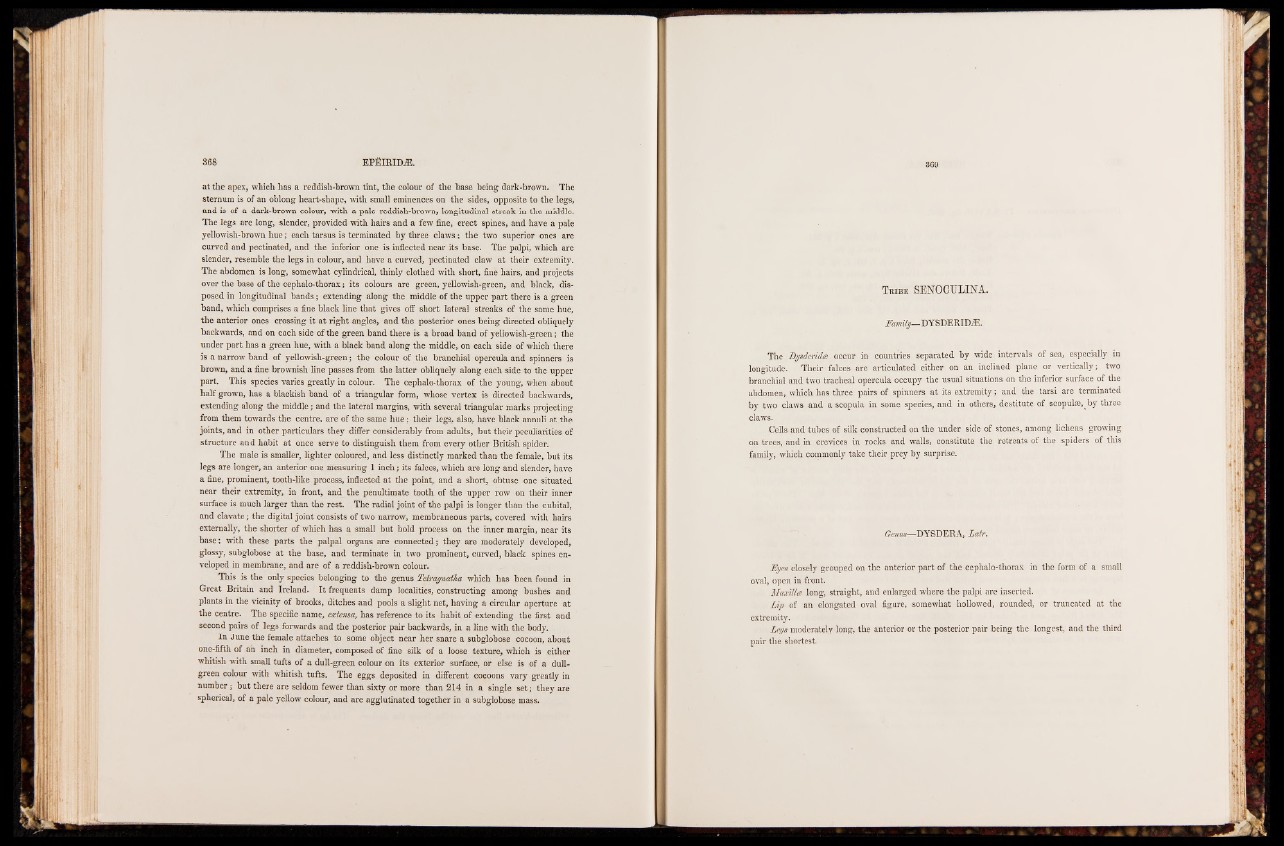
at the apex, which has a reddish-brown tint, the colour of the base being dark-brown. The
sternum is of an oblong heart-shape, with small eminences on the sides, opposite to the legs,
and is of a dark-brown colour, with a pale reddish-brown, longitudinal streak in the middle.
The legs are long, slender, provided with hairs and a few fine, erect spines, and have a pale
yellowish-brown hue; each tarsus is terminated by three claws; the two superior ones are
curved and pectinated, and the inferior one is inflected near its base. The palpi, which are
slender, resemble the legs in colour, and have a curved, pectinated claw at their extremity.
The abdomen is long, somewhat cylindrical, thinly clothed with short, fine hairs, and projects
over the base of the cephalo-thorax; its colours are green, yellowish-green, and black, disposed
in longitudinal bands; extending along the middle of the upper part there is a green
band, which comprises a fine black line that gives off short lateral streaks of the same hue,
the anterior ones crossing it at right angles, and the posterior ones being directed obliquely
backwards, and on each side of the green band there is a broad band of yellowish-green; the
under part has a green hue, with a black band along the middle, on each side of which there
is a narrow band of yellowish-green; the colour of the branchial opercula and spinners is
brown, and a fine brownish line passes from the latter obliquely along each side to the upper
part. This species varies greatly in colour. The cephalo-thorax of the young, when about
half grown, has a blackish band of a triangular form, whose vertex is directed backwards,
extending along the middle; and the lateral margins, with several triangular marks projecting
from them towards the centre, are of the same h u e ; their legs, also, have black annuli at the
joints, and in other particulars they differ considerably from adults, but their peculiarities of
structure and habit at once serve to distinguish them from every other British spider.
The male is smaller, lighter coloured, and less distinctly marked than the female, but its
legs are longer, an anterior one measuring 1 inch; its falces, which are long and slender, have
a fine, prominent, tooth-like process, inflected at the point, and a short, obtuse one situated
near their extremity, in front, and the penultimate tooth of the upper row on their inner
surface is much larger than the rest. The radial joint of the palpi is longer than the cubital,
and clavate; the digital joint consists of two narrow, membraneous parts, covered with hairs
externally, the shorter of which has a small but bold process on the inner margin, near its
base; with these parts the palpal organs are connected; they are moderately developed,
glossy, subglobose at the base, and terminate in two prominent, curved, black spines enveloped
in membrane, and are of a reddish-brown colour.
This is the only species belonging to the genus Tetragnatla which has been found in
Great Britain and Ireland. It frequents damp localities, constructing among bushes and
plants in the vicinity of brooks, ditches and pools a slight net, having a circular aperture at
the centre. The specific name, externa, has reference to its habit of extending the first and
second pairs of legs forwards and the posterior pair backwards, in a line with the body.
In June the female attaches to some object near her snare a subglobose cocoon, about
one-fifth of ah inch in diameter, composed of fine silk of a loose texture, which is either
whitish with small tufts o f a dull-green colour on its exterior surface, or else is of a dull-
green colour with whitish tufts. The eggs deposited in different cocoons vary greatly in
number; but there are seldom fewer than sixty or more than 214 in a single set; they are
spherical, o f a pale yellow colour, and are agglutinated together in a subglobose mass.
T r ib e SENOCULINA.
Family— DYSDERIDE.
The Lysderida occur in countries separated by wide intervals of sea, especially in
longitude. Their falces are articulated either on an inclined plane or vertically; two
branchial and two tracheal opercula occupy the usual situations on the inferior surface of the
abdomen, which has three pairs of spinners at its extremity; and the tarsi are terminated
by two claws and a scopula in some species, and in others, destitute of scopulas, by three
claws.C
ells and tubes of silk constructed on the under side of stones, among lichens growing
on trees, and in crevices in rocks and walls, constitute the retreats of the spiders of this
family, which commonly take their prey by surprise.
Genus—DYSDERA, Latr.
Eyes closely grouped on the anterior part of the cephalo-thorax in the form of a small
oval, open in front.
Maxilla long, straight, and enlarged where the palpi are inserted.
Lip of an elongated oval figure, somewhat hollowed, rounded, or truncated at the
extremity.
Legs moderately long, the anterior or the posterior pair being the longest, and the third
pair the shortest.